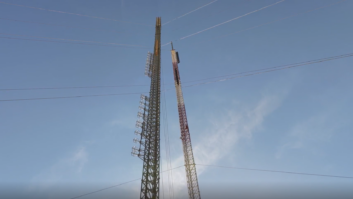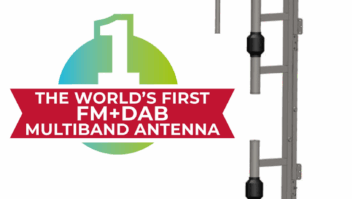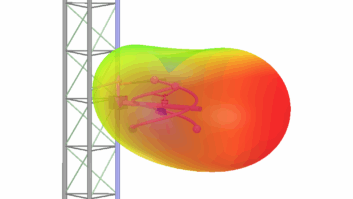Firms Develop Top-Loaded Cage Monopole AM Design
BRISTOL, Va. Preliminary test data indicate that a new low-profile AM antenna design, now under development, could someday be an alternative for AM broadcasters by allowing for easier zoning approval of antenna projects and offering a less-expensive option to quarter-wave monopole antennas.
Other developers of short antennas have failed to gain FCC approval in the past, prompting skeptics to wonder if such short antennas will ever be effective radiators. But the companies developing this design say field measurements from a test site in southwest Virginia indicate their top-loaded cage monopole AM antenna is approximately 96 to 98 percent as efficient as a standard quarter-wave monopole antenna at less than one-third the height.
STAR-H Corp. and Kintronic Laboratories Inc. are partnering on the venture, using the name Kinstar for the new antenna. A full-scale version of the Kinstar low-profile antenna was tested in November under a special experimental license from the FCC at 250 watts on 1680 kHz near Bristol, Va. Consulting engineer Don Crane took field measurements for Kintronic over several weeks.
STAR-H officials said the test antenna was 45 feet high and 105 feet in diameter over a full 120-radial ground screen and supported by wooden poles. The horizontal loading wires were 95 feet in length. The four vertical wires were spaced evenly on a circle with radius of five feet.
Officials said in permanent installations, the system would use a standard 120-foot quarter-wave buried ground system. The company has patent applications for the antenna concept pending for both the U.S. and international markets.
Tom King, president of Kintronic Labs, said his company has a licensing agreement to market and sell the antenna in the United States once the firm obtains the required FCC approval.
“If the final data shows that it works with field proofs, we hope to have FCC approval for use in the U.S. by early next year (2003),” King said. “So far, all indications are that it worked to our expectations. It has very good bandwidth characteristics with a minimal amount of network matching needed.”
King said a standard 146-foot-tall quarter-wave monopole antenna was first constructed on the test site and field measurements taken. The antenna then was dismantled and replaced with the Kinstar antenna.
The field strength measurements of both antennas were being evaluated in early December by Ron Rackley of duTreil, Lundin and Rackley Consulting Engineers.
In his preliminary assessment of the Kinstar, Rackley wrote, “I have not graphically analyzed the sets of data, but I have been able to review them in tabular form and can say that the Kinstar configuration appears to produce unattenuated field values that are within 5 percent of that produced by the quarter-wave reference antenna … and are in excess of the minimum efficiency that is required for most AM radio stations by FCC rules.”
Rackley declined further comment citing a confidentiality agreement with Kintronic.
Quick installation
King said the Kinstar consists of four electrically short, vertical closely spaced elements, each of which is terminated in a horizontal top load element. Each vertical element is fed via a phase-matched section of 50-ohm transmission line.
King said his company used a Nautel P-400 transmitter for the tests.
In addition to being shorter than a standard quarter-wave monopole antenna, the Kinstar antenna can be constructed rapidly and at a cost savings to broadcasters, King said.
“It can use wooden or reinforced concrete poles as vertical supports. Construction time will be cut dramatically. It could serve as a drop-in replacement. The new antennas will not require FAA lighting or marking in most cases,” King said.
Kintronic has modeled the Kinstar using steel supports, which demonstrated that steel supports could also be used, King said.
“The antenna will offer broadcasters in the mid- to low end of the AM band a big cost advantage through the antennas simplicity of erection. Communities should be more receptive to the new design since the visual impact of the Kinstar is greatly reduced over quarter wave monopole designs.”
King declined to give an estimate of what the Kinstar antenna would cost once it is brought to market. “That would be dependent on final configuration, the matching network and location,” he said.
‘Substantial’ market
Broadcaster interest in the Kinstar has been high, King said.
“We have had preliminary discussions with Clear Channel and some other major broadcast groups. Of course it all depends on receiving FCC approval, but we feel there will be a substantial market for it eventually, both here in the U.S. and worldwide,” King said.
Neither company would comment on how much money has been invested in the development of the technology.
Dr. James Breakall, a professor in the Department of Electrical Engineering at Pennsylvania State University, is the inventor of the low-profile antenna, said Mike Jacobs, director of research and development for STAR-H.
Jacobs, an adjunct professor of electrical engineering at Penn State, and another faculty member at the school founded the company in 1999 with hopes of taking their academic research technology into the commercial market.
“STAR-H is engaged in research and development of advanced antenna systems for broadcast and commercial applications,” Jacobs said.
“Data taken from the test site in Virginia seems to confirm what our computer modeling has shown,” Jacobs said. “The benefit will be reduced height but high efficiency.”
Jacobs said the Kinstar antenna consists of the same volume of antenna as a standard quarter-wave. “It’s just a tower with the legs peeled down, if you will, and run them out horizontally. We are trading a little horizontal extent for height and that is how we are able to preserve the efficiency,” Jacobs said.
A short antenna typically offers a difficult impedance to match the 50-ohm transmission line. The matching network, depending upon the impedance of the antenna, can introduce a lot of loss into the system, Jacobs said.
“The matching network from Kintronic doesn’t have to work very hard, so you have less loss and wider bandwidth. And that’s important with IBOC to make sure you have the bandwidth to cover all of the side bands for the hybrid digital transmission,” Jacobs said.
Jacobs said in-band, on-channel digital audio tests with the Kinstar were scheduled to take place in December.
The Kinstar antenna should be able to serve in AM directional arrays, Jacobs said.
“We have used the two-wire version of the antenna for directional arrays. We think the versatility with the four-wire version can be used in directional applications,” Jacobs said.
Jacobs said the efficiency of the Kinstar is still based mainly upon the ground system. “We are looking for ways to improve the area requirements for the ground or improve the efficiency. We are even studying elevated radials as a future consideration,” he said.
Station engineers will find some familiarity with the Kinstar, Jacobs said.
“Engineers will be able to test the current into the antenna to verify the power output will be done the exact same way engineers are use to doing it right now.”
The new antenna will give Class B and C AM broadcasters the chance to locate a better signal closer to the community they serve, Jacobs said.
“Anything that gives a station looking for a new site some options and that reduces the land requirements is a good thing for broadcasters,” Jacobs said.
Watching, waiting
Several technical consultants say they are waiting for the final analysis on the Kinstar antenna before deciding if the new technology will be suitable for use by AM broadcasters in the US.
“I am awaiting final test results from Kintronic (before I make up my mind). You can make anything radiate, the question is if you can drive it efficiently,” said Ben Dawson, of the Hatfield-Dawson technical consulting firm.
Stanley Salek, a consulting engineer with Hammett and Edison Inc., said the Star-H antenna design has directional array applications, but is mainly focused on approving overall feed and ground-wave radiation efficiency while reducing element height above ground.
“My main concern focuses on a lack of specific elevation plane radiation characteristics. There has been very little specific discussion on elevation plane pattern or skywave performance to this point,” Salek said.
Salek said that in “highly restricted” areas, the Star-H design could prove to be very useful. “But for practical use by stations other than daytimers and Class C stations, more has to be known,” he said.







